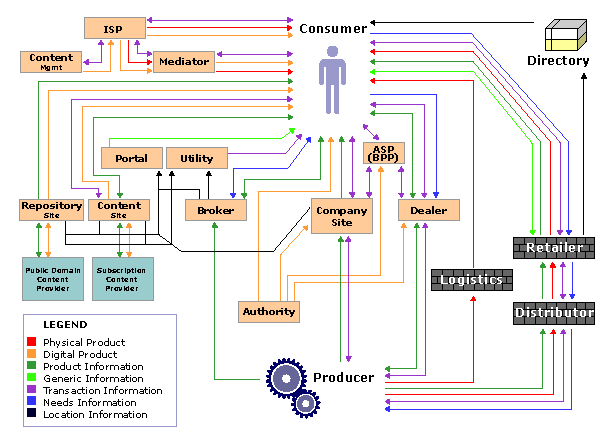| Lesson 8 | Transact stage |
| Objective | Describe the transact market flow stage. |
Transact Market Flow Stage

- A consumer interacts with ISP and Content management.
- There is two way communicatipm between Distributor and Retailer.
- The Retailer communicates with the Directory and Consumer.
- Producer communicates with company site that communicates with the Consumer.
Transact Stage
The primary aspect of the transact stage is the ability to purchase products over the Web.
This required many, many profound developments in technology and physical goods distribution and logistics.
To transact orders and payments over the Web now imposed a significantly higher level of security and access control than was required when the Web was simply an information distribution mechanism. Security-driven technologies, such as encryption, SSL, Kerberos, and PKI, as well as certificate authorities to support authentication and authorization for financial transactions emerged in the Transact stage.
Logistics and Web Purchases
Advanced logistics were required to support Web purchases. Previously, logistics organizations were set up for business-to-business transport.
Producers shipped truckloads to distributors. Distributors shipped quantity to retailers.
The "last mile" (to use a telephony analogy), was the responsibility of the consumer because the consumer came to the retailer to take delivery.
Producers now needed the ability to move goods directly from the producer to the consumer. There was not a logistics company in the world set up to handle that. What we saw was the massive, unprecedented expansion of UPS, the U.S. Postal Service and Federal Express, revamping their infrastructure to handle massive quantities of single unit shipments.
As soon as we had the security mechanisms in place to support the financial activities, and the logistics capabilities in place to support physical distribution, there was nothing to stop transacting business on the Web. We saw company sites add ordering capability to their Web sites. Company sites would now deliver product information and transact the sale of products. Then they would outsource delivery to a logistics organization. If we compare the company site capabilities at this stage to the traditional retailer, we find that two important communications channels are missing:
Producers now needed the ability to move goods directly from the producer to the consumer. There was not a logistics company in the world set up to handle that. What we saw was the massive, unprecedented expansion of UPS, the U.S. Postal Service and Federal Express, revamping their infrastructure to handle massive quantities of single unit shipments.
As soon as we had the security mechanisms in place to support the financial activities, and the logistics capabilities in place to support physical distribution, there was nothing to stop transacting business on the Web. We saw company sites add ordering capability to their Web sites. Company sites would now deliver product information and transact the sale of products. Then they would outsource delivery to a logistics organization. If we compare the company site capabilities at this stage to the traditional retailer, we find that two important communications channels are missing:
-
The consumer's ability to communicate need for a good or service.
Whereas the traditional brick and mortar retailer carrying a variety of products could more directly translate the customer's need into an
appropriate solution, online company sites understood need as the product itself.
-
The flow of generic information
Brick and mortar retailers maintained the flow of generic information, which continued to foster the sense of community.
Brokers and dealers
In response to these shortcomings, two new players burst onto the scene:
- brokers and
- dealers.
Application Service Providers
For many small- to medium-sized companies and dealers, the cost of the necessary technology to effect secure payments was prohibitive. In response, we saw the first ASP (application service provider) emerge around the function of bill payment and presentment. The consumer would transact the purchase with the company site or dealer. The company site or dealer would provide the transaction information to the ASP. The consumer made the payment directly to the ASP.
As more and more commerce transitioned to the Web, the role of the ASP carried a secondary benefit.
Consumers were faced with a new issue, namely the consumer needed to log into company A to pay for the goods purchased from Company A. The consumer needed to log into Dealer B to pay for the goods and services transacted with Dealer B and so on. Through a common ASP the consumer could now log into a single site and disperse payment for multiple obligations.
For example, CheckFree let consumers pay for phone bills, purchases, or other purchases all through one site.
At about this same time, digital product distribution began to exhibit the same channel limitations that have historically plagued the physical product channels. Too many individuals downloaded single-sourced content at one time, clogging the system. Content management companies emerged to distribute and synchronize large quantities of digital product data across multiple ISPs.
As more and more commerce transitioned to the Web, the role of the ASP carried a secondary benefit.
Consumers were faced with a new issue, namely the consumer needed to log into company A to pay for the goods purchased from Company A. The consumer needed to log into Dealer B to pay for the goods and services transacted with Dealer B and so on. Through a common ASP the consumer could now log into a single site and disperse payment for multiple obligations.
For example, CheckFree let consumers pay for phone bills, purchases, or other purchases all through one site.
At about this same time, digital product distribution began to exhibit the same channel limitations that have historically plagued the physical product channels. Too many individuals downloaded single-sourced content at one time, clogging the system. Content management companies emerged to distribute and synchronize large quantities of digital product data across multiple ISPs.
B2B Digital Marketing Strategy